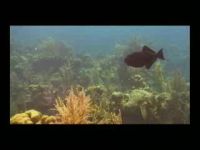
The Silk Caye Range – they’re a precious chain of small
islands in Belize’s southern waters that constitute a marine reserve.
Last night we gave you a preview of our visit to the range along with senior
members of the Oceana Foundation. Tonight we take a more thorough look at the
Silk Cayes and the wider threats to Belize’s marine ecosystem.
Jim McFadzean Reporting,
The news is troubling, our once pristine waters are now contaminated and the
Belizean reef is now in worst shape than that of our neighbours, Mexico and
Honduras, and so the once Great Barrier Reef of the Western Hemisphere is now
added to UNESCO’S list of endangered World Heritage sites.
Keith Addis, Chairman of the Board
“There are very few fish and this is a marine protected area and when
I tell you there are very few fish, I mean maybe we saw 50 or 60 fish total
in 45 minutes in this whole area we were diving. So we are concerned about the
marine life here.”
Those were the words of OCEANA’s Chairman of the Board who came down
to Belize to personally see and assess for himself the state of Belize’s
marine life. The advocacy group is fairly new to Belize, but its ties and investment
in the wider Mesoamerica region is nothing new.
Keith Addis,
“Oceana is focused on three principal issues: over fishing, and I  think we all know that 70%, maybe more, of all the big fish that people like
to eat have been fished out of the ocean for ever. Over fishing is a big issue
we are focusing on. Habitat destruction, this is one of the reasons this reef
is so incredibly important to all of us because it is an important part of the
nursery system and the habitat for so many important forms of sea life. And
the third is pollution and whether or not anyone believes in climate change,
which in I do, maybe you don’t, we all know that 22 million tonnes of
CO2 is being absorbed into the ocean everyday. 22 million tonnes a day. It is
a staggering amount.”
think we all know that 70%, maybe more, of all the big fish that people like
to eat have been fished out of the ocean for ever. Over fishing is a big issue
we are focusing on. Habitat destruction, this is one of the reasons this reef
is so incredibly important to all of us because it is an important part of the
nursery system and the habitat for so many important forms of sea life. And
the third is pollution and whether or not anyone believes in climate change,
which in I do, maybe you don’t, we all know that 22 million tonnes of
CO2 is being absorbed into the ocean everyday. 22 million tonnes a day. It is
a staggering amount.”
And so as Belize increase the pace of its development, Tourism has become a
double edge sword.
Keith Addis,
“Ultimately tourism is such an important business, a fantastic business
here, and maintaining that level of tourism is going to largely be a function
of how well the Belizeans can conserve what’s gorgeous and what’s
attracting so many people to come and see the beauty of this place.”
Dr. Michael Hirschfield, Senior Marine Biologist
“Belize has done a lot right with how you develop, you don’t
have the giant mass hotels, the giant mass tourism, but every mangrove tree
that is cut down for development is not helping the reef, it is hurting the
reef and so paying attention to how and where development takes place. It is
not don’t develop, it is develop wisely.”
The head of Oceana Belize, Audrey Matura says Oceana couldn’t have made  its presence in Belize at a more opportune time.
its presence in Belize at a more opportune time.
Audrey Matura Sheppard, Vice President – Oceana Belize
“When we look at destructive gears then we are also looking at the
protection of the reef. Also when we look at the protection of habitats, the
ecosystem is all interconnected and interrelated. When we look at all the different
areas where gill netting takes place, where trawling takes place, where fishing
takes place – we are not saying these things shouldn’t happen but
we are asking that they be done sustainably because when they do that then what
they are doing in the long term, everything in Belize goes right back to the
reef. Development on the land affects the reef. The way we fish or how much
fishes we capture affects the reef, the viability of the reef.
On the issue of foreign fleets it affects the reef because the truth is
we do not have an infinite amount of fish life and marine resources in Belize.
So we have to be able to use some, leave some for it to replenish. So now if
we allow foreigners to come and take over and bring better gears with higher
capacity, it will do several things. Economically and socially it will displace
our artisanal fisherman and at the same time it will destroy our resources and
the amount we have.”
So what will it take and how long will it take for the home of the Western
Hemisphere’s largest marine population to recover from man’s excesses?
Dr. Michael Hirschfield,
“I think it will take being more careful with development so that
we don’t destroy the mangroves and the fish nurseries around the edges
of the ocean. It will also take being more careful about fishing, making sure
that Belize doesn’t let foreign fleets come in and catch the fish. Maybe
we have to be a little bit more careful in where we fish so maybe some less
bottom trawling, maybe some care with gill nets. Traditional fishing methods
are good but you can’t keep putting the pressure on the reef that it has
had for the last couple of decades and expect it to be healthy.”
The race is on full steam ahead as both Belize and its International
partners are teaming together to ensure that the Great Barrier Reef; and its
pristine waters don’t enjoy the same fate as Belize’s once flourishing
logwood forests. Reporting for Seven News, I’m Jim McFadzean.



